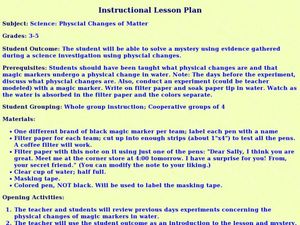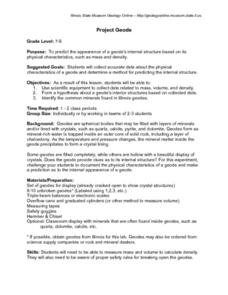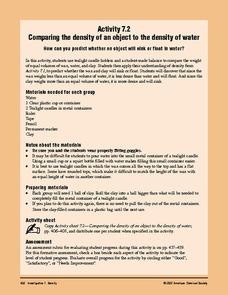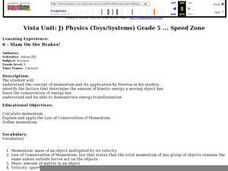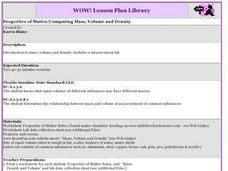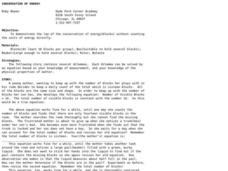Curated OER
Matter: Three States of Matter
Students discover characteristics of each of the three states of matter: solid, liquid and gas.
Curated OER
Three States of Matter
Students explore the three states of matter. In this matter lesson, students are shown a variety of examples and decide whether it is a liquid, solid or gas. Students brainstorm what characteristics the objects in each group share.
Curated OER
Matter
Fifth graders investigate the structure of matter. They examine pictures of atoms and molecules and discuss their relationships, and construct a model of a molecule using toothpicks and gumdrops.
Curated OER
What is Matter?
Sixth graders are read Goodnight Moon. They discuss the different kinds of
matter mentioned in the story. Students describe each item
they remember, they are encouraged to observe that some things are
made of smaller pieces, different...
Curated OER
What's the Matter?
Students use knowledge of the states of matter while creating an informational book on solids, liquids, and gases. They watch a class video about matter and then discuss what they know about the three types.
Curated OER
Physical Changes of Matter
Students solve a mystery using evidence gathered during a science investigation. In this physical changes lesson, students analyze a note written in marker to determine the physical changes the ink from the pen underwent....
Curated OER
What's the Attraction
Students sort objects based on magnetism. In this magnetism lesson, students are given a variety of objects, then predict whether the object will be attracted to a magnet and test their hypothesis as they sort the objects into "yes" and...
Curated OER
Chemical Wonders
Students read about and discuss how chemical engineers use different states of matter to create substances. For this chemical engineering lesson plan, students also give examples of the 3 kinds of matter.
Curated OER
Name that metal!
Learners have to have had some experience with metals prior to using this worksheet. They are given five properties common to five different metals. They create or use a dichotomous key to identify the five mystery metals. Tip: This...
Curated OER
UP AND ATOM
If you are willing to sort through this outline and overlook the portions relating to inaccessible videos, you will find a wealth of support for your introductory chemistry unit. Narrative is presented to help you help learners navigate...
Curated OER
Water 1: Water and Ice
Students discover the forms water can take. In this hands-on science lesson plan, students examine how water can change from a solid to a liquid and then back again.
Curated OER
Sorting Plastics For Recycling
First, young chemists practice polymer identification by density and flame tests. With the data collected, they propose a method of separating polyethylene from other plastics and determine what property makes it desirable for recycling....
Curated OER
Project Geode
Young geologists attempt to predict the appearnace of a geode's internal structure based on how it looks from the outside, its mass, and its physical characteristics. For this geologly lesson, learners use scientific equipment to collect...
Mascil Project
Sports Physiology and Statistics
If I want to build up my heart, where should I start? Science scholars use statistics in a sports physiology setting during an insightful experiment. Groups measure resting and active heart rates and develop a scatter plot that shows the...
American Chemical Society
Change in Temperature - Exothermic Reaction
Alone, or as part of the intended unit on chemical reactions, this activity allows learners to experience an exothermic reaction. Here, learners add calcium chloride to a baking soda solution and watch the temperature rise! They will...
American Chemical Society
Comparing the Density of an Object to the Density of Water
Investigators construct a makeshift balance and compare equal volumes of wax and water. They do the same for clay and water. Then they discover whether the wax and clay will float or sink in water. Ultimately this is a comparison of...
Curated OER
Cup Capacity Tool: Measuring Cup
Students examine containers and their capacity. They fill a one-cup measuring cup with water and pour cups of water into other containers. Through observation, students discover how many cups make a pint, and how many teaspoons make a...
Curated OER
Slam On the Brakes!
Fifth graders study the concept of momentum and its application by Newton in his studies. They view a demonstration and complete an experiment with toy cars on a racetrack that shows them the properties of momentum and how velocity and...
Beyond Benign
Writing the Principles
What is the difference between chemistry and green chemistry? The first activity of the 24-part green chemistry series introduces scholars to its 12 principles. The tendency is toward nontoxic materials and sustainability.
Curated OER
Describing the Physical World
In this physical world worksheet, students review concepts relating to the chemical and physical properties of matter, density of matter, and if matter is a solid, liquid, or gas. This worksheet has 9 terms in a word puzzle, 4 true or...
Curated OER
Properties of Matter/Comparing Mass, Volume and Density
Pupils participate in a discussion of volume and density and then engage in a hands on lab. They weigh equal volume cubes at lab stations of an assortment of common substances in a lab setting and record data on their findings on...
Curated OER
Solids, Liquids and Gases - Part 2
Students experiment with balloons, soda water and raisins to find out about the states of matter. In this solids, liquids and gases lesson plan, students complete a group activity with balloons to recognize the state of matter in...
Curated OER
Density - An Introduction
Students experiment with objects of different densities. In this density lesson plan, students examine same-sized objects with different weights, then look at a teacher explanation of density. Students make wave bottles and a density...
Curated OER
Conservation of Energy
Students investigate the law of conservation of energy. In this conservation of energy lesson plan, students are given a story with several dilemmas to be solved by an equation, knowledge of measurement and knowledge of physical...







